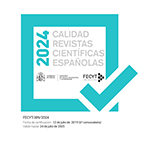Saavedra Fajardo and Velázquez: Princes mirrors in Westfalia crisis
Abstract
This paper analyzes the variations and metamorphosis that some iconographic motives undergo in Saavedra Fajardo and Diego Velazquez. Moreover it examines the way in which these works show the Westfalia epoch —a moment of crisis in the Empire and the construction of a new European political order. One could reconstruct the model of the good government during the reign of Felipe IV by analyzing some of the main iconographical motives in Velazquez paintings and Saavedra’s emblems (the mirror, the shipping, the horse riding, the torch, the tabula rasa): on the one hand the way in which it fits in the ideal of the pastoral power as Foucault said; on the other hand it shows the arise of a new form of domination that is represented as a sovereign figure who sees everything but cannot be seen. Firstly the main contributions to the study of Las Meninas will be revised regarding the tradition of the prince mirrors. Secondly new analogies between this work and Saavedra’s Empresas will be proposed —analogies which emphasize the meninos’ role in the ideal of the prince education. Finally both the main contribution to the study of the mirror metaphor in Saavedra’s work and its comparison with Las Meninas will be revised. Analogies between the government of the state ship and the self-government allow emphasizing the way these prince mirrors show the genealogy of the modern subject construction.Downloads
Article download
License
In order to support the global exchange of knowledge, the journal Res Publica. Revista de Historia de las Ideas Políticas is allowing unrestricted access to its content as from its publication in this electronic edition, and as such it is an open-access journal. The originals published in this journal are the property of the Complutense University of Madrid and any reproduction thereof in full or in part must cite the source. All content is distributed under a Creative Commons Attribution 4.0 use and distribution licence (CC BY 4.0). This circumstance must be expressly stated in these terms where necessary. You can view the summary and the complete legal text of the licence.









